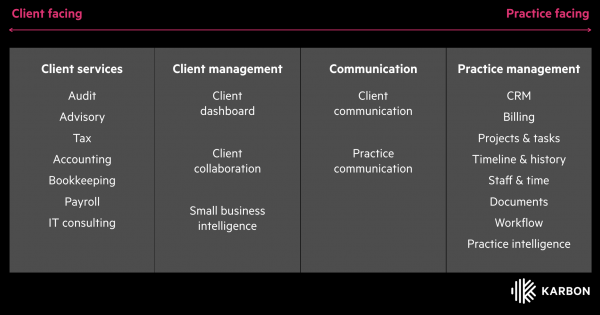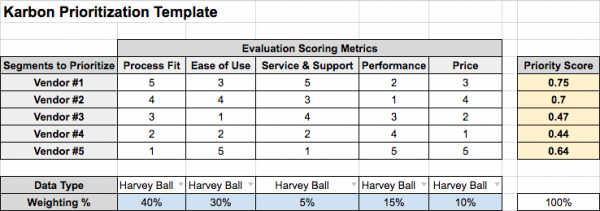Selecting the right technology for the modern accounting practice

Technology for accounting professionals has radically changed in the last decade. The advent of cloud accounting has signaled a new era of industry-specific applications—some designed for small business verticals and others specific to modern accounting practices and their unique workflows.
This evolution is presenting you with game-changing opportunities for efficiency improvements and automation, but the sheer number of technology options out there introduces a new challenge. How can you navigate the huge sea of apps and systems to pick the right solutions for your firm and clients?
These nine steps will help you narrow the field of apps and ultimately select the best option for the problem or process you are looking to solve.
1. Identify your major issues (and opportunities)
Technology is only as good as the processes it stands on, so to begin, look at what isn't running as well as it should in your firm. Identify processes that are inefficient, create bottlenecks or take too long to complete. Alternatively, focus on any areas you think are good, but could still be done better—such as client onboarding.
The right question to ask yourself is “what’s wrong with my firm’s workflows and processes”, rather than “what new technology can I implement?”. By identifying inefficiencies first, you can then implement the right technology that will help you fill those gaps. Doing the reverse can waste time, money and energy, and you risk breaking workflows that might already work perfectly well.
2. Prioritize your infrastructure
Addressing all of your firm's problems at once isn’t feasible. With the right planning, you can focus on your top strategic priorities and address your biggest workflow issues first.
This diagram of a modern, full-service accounting firm shows services provided to clients on the left and the workflows needed to support the firm to the right. In between is what bridges the gap between servicing and supporting.

Using the diagram, rank the infrastructure components that are the most important to your firm. This will give you a roadmap of what to consider first. The categories you need will depend on your size, type and focus. If you don’t do tax or time tracking you can eliminate them from consideration. If your highest margins coming from advisory, small business and practice intelligence categories might be your top priorities.
3. Review the options for your top priorities
Explore options for each category, beginning with your top priority.
You can also look at peer review databases such as:
Intuit's apps.com
Xero's app marketplace
Remember that any new app you consider should integrate with the systems you’re currently using, so where applicable, pay attention to the database of add-ons for any of your current systems.
4. Evaluate the vendors
By now you should understand your problem and have a sense of the options you have to solve it. Based on that, explore the vendors you have identified to understand what differentiates them and which ones might be worth shortlisting.
Try not to get carried away and spend too much time on this step. Consider setting a time limit for each evaluation. For instance, if you have 8 vendors to review set aside 2 hours one afternoon, allocating no more than 20 minutes per vendor to draw initial conclusions on.
By doing this, you force yourself to see the entire landscape while not over-investing on any particular vendor.
5. Decide what's most important
Following your vendor evaluation, you’ll have a sense of what apps to consider further and what to eliminate. Just as importantly—and maybe without realizing—you’ll have formed an idea of criteria to evaluate your options.
You need to know what you're looking for—the system characteristics that are most important to you and your team. So your next task is to choose three to five criteria that you'll use to evaluate your shortlisted technology.
Product training
Customer service
Workflow fit
Scalability
Ease-of-use
Price
Reporting
Integrations
Performance
System switching cost
6. Assign a weighting
With 100 points to spend in total, assign a weighting for each of the 3-5 characteristics you chose in Step 5, based on how vital they are—their combined points should total 100. Ideally, you don’t want your criteria to be evenly weighted.
For example, you might weight 4 criteria with points of 50, 30, 10 and 10 points. This step will enable you to develop an equation for your qualitative analysis, which removes the risk of your outcome being influenced by any bias.
7. Score your options
With your criteria decided and ranked, and vendors shortlisted, you should now give a score to your shortlisted options in each of the evaluation criteria. For this step, use a Harvey-Ball style analysis, where each app is given a score between 1 (poor) to 5 (excellent) for each criterion.
For instance, if one of the categories you're looking at is price, you would give the cheapest option a 5 and the most expensive a 1 in that area. If you're rating ease-of-use, look at customer reviews and give what looks like the most intuitive a 5, and the most difficult a 1.
If you rate each app against the others you have shortlisted, and force yourself to have different scores for all options in each criterion, it will be much clearer to settle on an eventual winner.
8. Calculate your scores
The simplest way to calculate your scores is using a metric that takes into account the weighting you assigned in Step 6.
If you chose three criteria (X, Y, Z), weighted them (Wx, Wy, Wz), and scored them across two vendors (Sx1, Sy1, Sz1 vs. Sx2. Sy2, Sz2 respectively), your comparable scores would be:
• Score (vendor #1) = Wx * Sx1 + Wy * Sy1 + Wz * Sz1
• Score (vendor #2) = Wx * Sx2 + Wy * Sy2 + Wz * Sz2
Identifying your overall winner—the vendor with the largest score—will be easy, and you'll know what option is your best fit.
Download this free Technology Prioritization template to help you with this step.

9. Trial your winner
With a winner identified, you need to try it out first-hand to determine whether it truly is the right fit for your firm. If two options are close in scores, you should try to test them both.
Signup for a free trial, watch a product demo, upload your practice's data, and try it out for one or two weeks. Sampling the product is the only way you can make a genuinely educated decision. Does it live up to your expectations? Will it solve your problem? If not, look at the second place winner and repeat.
There are endless accounting technology options your practice can consider, and keeping across all of them would require you to spend every waking moment researching, exploring and testing. Rather than doing that, these steps will make the most of the time that you do have.
You'll confidently be able to identify the solutions that are right for your firm and clients, adopting the right technology at the right time that will make your firm more efficient and give you a vital competitive advantage.